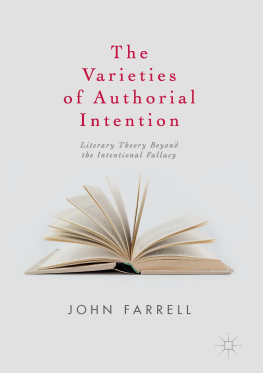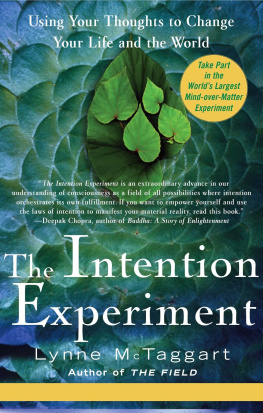Intention, Plans, and Practical Reason
INTENTION, PLANS, AND PRACTICAL REASON
MICHAEL E. BRATMAN
THE DAVID HUME SERIES
PHILOSOPHY AND COGNITIVE SCIENCE REISSUES

To my mother and father,
Anne and Harry Bratman
Copyright1999
CSLI Publications
Center for the Study of Language and Information
Leland Stanford Junior University
03 02 01 00 2345
Library of Congress Cataloging-in-Publication Data
Bratman, Michael.
Intention, plans, and practical reason I Michael E. Bratman.
p. cm.
Originally published: Cambridge, Mass.: Harvard University Press, 1987.
Includes bibliographical references.
ISBN 1-57586-192-5
1. Intentionalism. 2. Planning. I. Title.
BF619.5.B73 1999
128'.33dc21 99-12134
CIP
The David Hume Series of Philosophy and Cognitive Science Reissues consists of previously published works that are important and useful to scholars and students working in the area of cognitive science. The aim of the series is to keep these indispensable works in print in affordable paperback editions.
In addition to this series, CSLI Publications also publishes lecture notes, monographs, working papers, and conference proceedings. Our aim is to make new results, ideas, and approaches available as quickly as possible. Please visit our web site at http://csli-publications.stanford.edu/ for comments on this and other titles, as well as for changes and corrections by the author and publisher.

Preface
What happens to our conception of mind and rational agency when we take seriously future-directed intentions and plans and their roles as inputs into further practical reasoning? This question drives much of this book. My initial efforts with it resulted in a quintet of papers published between 1981 and 1985: "Intention and Means-End Reasoning," The Philosophical Review 90 (1981): 252265; "Castaeda's Theory of Thought and Action," in Agent, Language, and the Structure of the World: Essays Presented to Hector-Neri Castaeda, with His Replies, ed. James E. Tomberlin (Indianapolis: Hackett, 1983); "Taking Plans Seriously," Social Theory and Practice 9 (1983): 271287; "Two Faces of Intention," The Philosophical Review 93 (1984): 375405; and "Davidson's Theory of Intention," in Essays on Davidson: Actions and Events, ed. Bruce Vermazen and Merrill B. Hintikka (Oxford: Oxford University Press, 1985). (Material from "Two Faces of Intention" is included here in with the permission of The Philosophical Review.) In this book I develop further some of the main themes of these essays and also explore a variety of related ideas and issues. Although, no doubt, much remains to be said, my hope is that I have made the overall outlines of my answer to my question sufficiently clear that its general merit and usefulness for further research can reasonably be assessed.
Work on this book was made possible in part by a Fellowship from the American Council of Learned Societies, under a program funded by the National Endowment for the Humanities, during the academic year 198485. My work during that academic year was also supported by Stanford University, through its sabbatical leave program. During the past several years my work has benefited from the generous support and computer facilities provided by the Center for the Study of Language and Information, made possible in part through an award from the System Development Foundation. And I could not have written this book had it not been for the stimulating and supportive intellectual environment provided both by the Stanford University Philosophy Department and by the Center for the Study of Language and Information.
Donald Davidson first awakened my interests in the theory of action, and John Perry helped me develop these interests through many years of conversation as my colleague at Stanford. Most recently I have learned from an ongoing interdisciplinary seminar on rational agency conducted at the Center for the Study of Language and Information and from an informal graduate seminar based on an early draft of this book. Daniel Farrell and David Velleman both provided extensive and helpful comments on parts of earlier drafts.
I am also indebted to many others. Among them are Robert Audi, Lawrence Becker, Ned Block, David Brink, Hector-Neri Castaeda, Mark Crimmins, Arnold Davidson, Alan Donagan, Charles Dresser, John Dupr, John Etchemendy, John Fischer, Allan Gibbard, Gilbert Harman, David Hilbert, David Israel, Hugh McCann, Julius Moravcsik, Adrian Piper, Martha Pollack, Peter Railton, Jean Roberts, Kwong-loi Shun, Michael Slote, Holly Smith, Michael Stocker, Patrick Suppes, Howard Wettstein, and George Wilson. Ingrid Deiwiks kindly helped prepare the bibliography.
Susan Gross Bratman, Gregory Bratman, and Scott Bratman each provided support in her or his own special way and made my work on this book a lot more fun than it might have been.

Contents
chapter 1

Introduction
MUCH of our understanding of ourselves and others is rooted in a commonsense psychological framework, one that sees intention as central. Within this framework we use the notion of intention to characterize both people's actions and their minds. Thus, I might intentionally pump the water into the house, and pump it with the intention of poisoninghe inhabitants. Here intention characterizes my action. But I might also intend this morning to pump the water (and poison the inhabitants) when I get to the pump this afternoon. And here intention characterizes my mind.
Such characterizations are important to us in many ways. First, they are tied tightly to a wide range of emotional reactions, moral attitudes, and legal institutions. If I poison the inhabitants, but do not do so intentionally and do not act with the intention of poisoning them, you will react very differently to me than if I had acted with that intention and poisoned them intentionally; and so will our legal institutions. Second, these characterizations provide a basis for our everyday attempts to predict what others will do, explain what they have done, and coordinate our projects with theirs. You can predict my actions with some accuracy if you know of my prior intention to poison the inhabitants, and a later appeal to that intention might play an important role in an attempt to explain my actions at the pump. And your knowledge of my intention to poison the inhabitants may play a significant role in our joint attempt to steal the gold from the building they are in.
In this book I take some steps toward providing a systematic framework within which to understand these ways of characterizing mind and action in terms of intention. In doing this I am led to discuss a range of issues about intention, action, and practical rationality. Throughout, however, I am guided by a simple but, I think, powerful idea. This is the want briefly to clarify this underlying theme, and contrast it with a variety of ideas common to much recent philosophy of mind and action. This will lead me to touch briefly on several ideas that will be receiving detailed treatment in the chapters to follow. But in this introduction my main concern is to set out the general picture that will be guiding these later, more detailed discussions.
Next page











